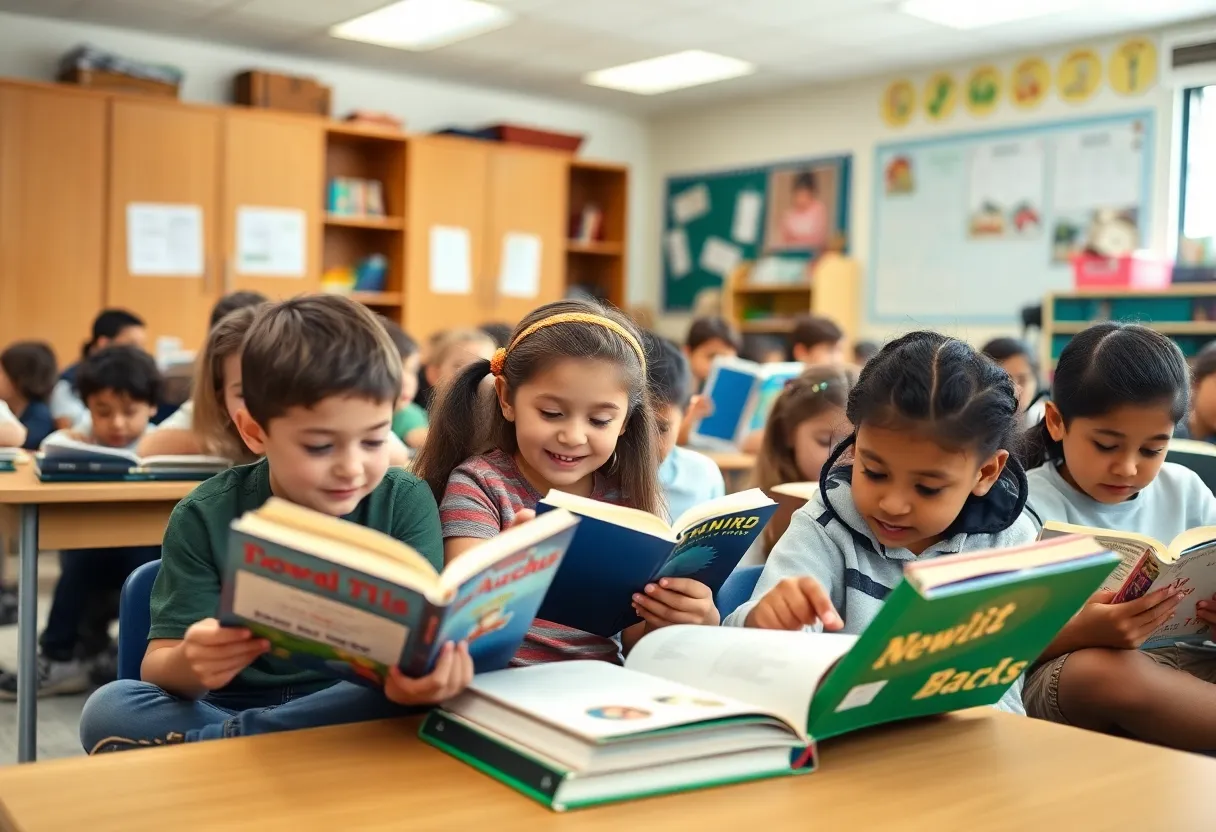Albuquerque, October 17, 2025
New Mexico’s third-grade literacy rates have reached 52% proficiency, reflecting an 8% improvement from the previous year, as reported by the Public Education Department. The rise is attributed to enhanced reading programs, particularly in Albuquerque, including phonics-based curricula and after-school tutoring. While schools like Whittier Elementary show significant gains, challenges in rural and low-income areas persist, highlighting the need for equitable resources. Future initiatives plan to expand successful programs statewide, aiming for a 60% proficiency rate by 2027.
New Mexico’s Third-Grade Literacy Rates Reach 52% Proficiency, Marking an 8% Increase
New Mexico’s third-grade literacy rates have climbed to 52% proficiency, an 8% rise from the previous year, according to a recent report from the Public Education Department released on October 17, 2025. This improvement highlights the effectiveness of targeted educational strategies across the state, particularly in urban areas like Albuquerque.
The gains stem from expanded reading programs implemented in Albuquerque districts and other regions. These efforts include the introduction of phonics-based curricula designed to build foundational reading skills and after-school tutoring sessions that provide additional support for struggling students. State officials attribute the progress to consistent application of these methods, which have helped more children meet proficiency benchmarks by the end of third grade.
Key initiatives such as the Read Aloud program have played a central role, reaching over 10,000 students with a focus on early intervention for at-risk readers. This program encourages interactive reading sessions to foster engagement and comprehension from an early age. In Albuquerque, specific schools have shown notable advancements; for instance, Whittier Elementary reported a 15% jump in proficiency rates, largely due to enhanced teacher training in evidence-based instructional techniques.
Challenges in Equity and Rural Areas
Despite the overall upward trend, disparities remain a concern, especially in rural and low-income communities. These areas often face limited resources, leading to slower progress compared to urban centers. The report underscores the need for sustained funding to address these gaps and ensure equitable access to quality literacy education statewide.
Educators and parents have expressed optimism about the results during recent virtual town halls, where stories of increased student confidence and motivation were shared. This positive feedback reinforces the value of community involvement in educational outcomes.
Future Plans and Statewide Expansion
The state intends to scale successful pilot programs to other districts, aiming to replicate the achievements seen in Albuquerque and similar areas. Monitoring will continue throughout the school year, with adjustments made to support systems based on ongoing data analysis. The long-term goal is to achieve 60% proficiency by 2027, aligning with broader national efforts to promote literacy equity.
Background on Literacy Improvement Efforts
New Mexico’s focus on third-grade literacy reflects a nationwide push to improve early reading skills, as these form the basis for academic success in later years. The 8% increase builds on previous years’ incremental gains, demonstrating that deliberate, evidence-backed interventions can yield measurable results. Phonics-based approaches, which emphasize sound-letter relationships, have been integrated into classroom routines, supplemented by tutoring that targets individual needs.
In Albuquerque, where many of the state’s largest school districts operate, the expansion of these programs has been particularly impactful. Teacher professional development has equipped educators with tools to identify and support diverse learners, contributing to the 15% improvement at schools like Whittier Elementary. The Read Aloud initiative, by involving over 10,000 students, has created a ripple effect, encouraging home-school partnerships that extend learning beyond the classroom.
However, the persistent challenges in rural and low-income areas highlight the uneven distribution of resources. These regions often contend with higher student-to-teacher ratios and fewer after-school opportunities, which can hinder progress. Addressing these inequities will require increased state funding and policy adjustments to bring rural schools up to par with their urban counterparts.
The virtual town halls have provided a platform for stakeholders to discuss these issues, with parents noting visible improvements in their children’s reading abilities and overall school engagement. This community-driven dialogue supports the momentum needed for continued advancement.
Looking ahead, the Public Education Department’s commitment to data-driven monitoring ensures that interventions remain effective. By scaling pilots and refining strategies, New Mexico positions itself to meet ambitious proficiency targets. This progress not only benefits individual students but also strengthens the state’s educational landscape as a whole.
In summary, the rise to 52% proficiency in third-grade literacy marks a significant milestone, driven by innovative programs and dedicated efforts in places like Albuquerque. While challenges persist, the path forward emphasizes equity and sustained investment to build on this success.
FAQ
What is the current proficiency rate for third-grade literacy in New Mexico?
New Mexico’s third-grade literacy rates have climbed to 52% proficiency.
How much has the literacy rate improved from last year?
The rate marks an 8% rise from the previous year.
What factors contributed to the improvement?
The gains stem from expanded reading programs implemented in Albuquerque districts and other regions, including phonics-based curricula and after-school tutoring sessions.
What is the Read Aloud program?
The Read Aloud program reached over 10,000 students with a focus on early intervention for at-risk readers.
How have specific schools in Albuquerque performed?
In Albuquerque, schools such as Whittier Elementary reported a 15% jump in proficiency rates, due to enhanced teacher training in evidence-based methods.
What challenges remain?
Disparities persist in rural and low-income areas, prompting calls for more funding.
What are the future goals?
The state plans to scale successful pilots statewide and aims for 60% proficiency by 2027.
Literacy Proficiency Trends in New Mexico
The following table outlines key features of New Mexico’s third-grade literacy progress, including current rates, improvements, and targeted initiatives.
| Feature | Details |
|---|---|
| Current Proficiency Rate | 52% |
| Year-over-Year Increase | 8% from last year |
| Key Initiatives | Phonics-based curricula, after-school tutoring, Read Aloud program (reaching over 10,000 students) |
| Local Impact Example | 15% jump at Whittier Elementary in Albuquerque |
| Challenges | Disparities in rural and low-income areas |
| Future Goal | 60% proficiency by 2027 |
Deeper Dive: News & Info About This Topic
HERE Resources
Albuquerque community honors educator Erma D. Lente
Albuquerque Financial Hub Opens with New Branch
Albuquerque Schools Report Cards Show Mixed Results
Albuquerque Welcomes Capra Bank’s New 10,000-Square-Foot Branch Amid Rapid Growth
ARSL Conference 2025 Highlights BMI’s Digital Solutions for Libraries





